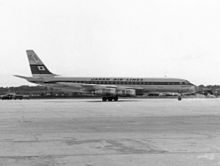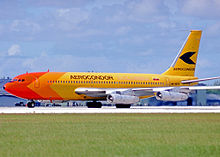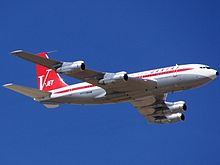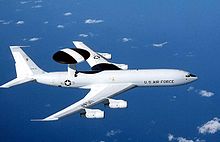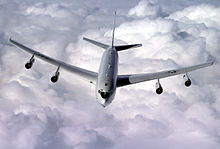Boeing 707
| Boeing 707 | |
|---|---|
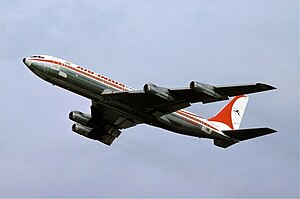 An Air India Boeing 707 |
|
| Type: | Four - engined narrow-body aircraft |
| Design country: | |
| Manufacturer: | |
| First flight: |
December 20, 1957 |
| Commissioning: |
October 26, 1958 |
| Production time: |
1957 to 1982/1991 |
| Number of pieces: |
1010 (incl. 154 Boeing 720) |
The Boeing 707 is a four - engined low - wing aircraft with a narrow hull produced by the US aircraft manufacturer Boeing . After the De Havilland Comet, the Boeing 707 was the first long-haul passenger aircraft equipped with jet engines . Together with the comparable Douglas DC-8 and other economically far less successful aircraft types of that time, it revolutionized civil aviation. A total of 1010 Boeing 707s in different civil and military versions were delivered. Today no aircraft flies in the civil passenger line service.
history
prehistory

Since the maiden flight of the first jet-propelled aircraft from the United States of America, the Bell XP-59 , numerous other aircraft manufacturers in the country have constructed machines that were equipped with the new drive technology. However, while the first passenger aircraft were equipped with jet engines in Great Britain with the De Havilland Comet and in Canada with the prototype of the Avro Canada C-102 , the United States of America initially did not follow this trend. The reasons for this were a lack of experience, the short service life of the engines, the high maintenance costs and the excessive consumption of kerosene. Another problem was the lack of the long and well-developed runways necessary for such aircraft. For this reason, Boeing initially concentrated on the further development of existing aircraft in the area of passenger aviation, such as the long-haul Boeing 377 passenger aircraft . Boeing has already developed jet-powered models for the military sector, for example the Boeing B-47 or the Boeing B-52 , and has gained experience here. In 1949 Boeing began work on the Boeing 367 (C-97). The plan with the name Boeing 367-40 envisaged equipping the aircraft with jet engines and offering it as a tanker , transport aircraft and passenger aircraft. The fuselage cross-section of the Boeing 367 was to be retained, which, due to the merging of two fuselages, did not have a circular or oval, but a characteristic shape that resembled the number 8.
At the same time, Boeing was considering offering the high-speed Boeing B-47 bomber in a passenger version with an extended fuselage for a maximum of 27 passengers. Since this conversion did not seem sensible, the focus was on the Boeing 367-40 project.
Development of the Boeing 367-80
The concept of the Boeing 367-40 finally changed to the actual Boeing 367-80 , which had little in common with the original 367. The cross-section of the fuselage continued to look similar to the number 8, but this was concealed on the outer skin by an aerodynamically favorable cladding. The sweep of the wings was 35 °, which was new in civil aircraft construction. On May 2, 1952, the then Chairman of the Board of Directors of Boeing, William McPherson Allen , decided to develop the Boeing 367-80, although no customer had been interested in the aircraft so far. The cost of this was $ 16 million, 50% of Boeing's total revenue at the time. In 1954 the United States Air Force (USAF) announced a competition for a new tanker, in which Boeing participated with the 367-80, which was also called Dash 80 (German: hyphen 80). The rollout of the machine took place on May 14, 1954, the first flight followed on July 15, 1954 from the Renton plant . Despite the military orientation, the prototype was registered civilly as N70700.
On October 5, 1954, the USAF ordered a Boeing 367-80 equipped as a tanker under the designation KC-135 . On July 13, 1955, the USAF allowed Boeing to offer the aircraft to customers for civil purposes; the Boeing 707 was developed from the latter.
Development of the Boeing 707
First, Boeing carried out surveys among the major airlines of the time. Above all, they called for a widened cabin, as they did not consider the 3.53 m diameter of the Boeing 367-80 to be sufficient. For the time being, a compromise was reached between the United States Air Force and Boeing to raise the fuselage cross-section by 11 cm. The wings, which are identical on the Boeing KC-135 and Boeing 707-100 models, have also been enlarged. Due to the major structural problems of the De Havilland DH.106 Comet , which had led to several crashes, Boeing concentrated particularly on structural loads on the aircraft components during the test phase. Large water tanks, for example, into which entire fuselages of the pre-production Boeing 707 were sunk, were used to help. Great improvements could be achieved in the necessary take-off route through more powerful engines and the installation of lift aids on the wings, and slow flight capabilities were also greatly improved.
Boeing initially had big problems with the slow sales talks, since the numerous crashes of the de Havilland DH 106 damaged the image of jet aircraft and since the purchase price of 4.5 million dollars was high compared to well-tried aircraft. In this situation, the successfully and safely flying Tupolev Tu-104 and the Sud Aviation Caravelle, which is currently under development, were able to remedy the situation : These forced American airlines to follow the trend of jet aircraft in order not to lose touch. Pan American World Airways was the first airline to order 20 copies on October 13, 1955 , but at the same time bought 25 Douglas DC-8s . The Douglas DC-8 program, officially announced in 1955, corresponded to or exceeded that of the Boeing 707 in terms of dimensions and flight performance. The greatest difference on this point was found in the fuselage cross-section. For example, the DC-8 should accommodate six passengers per row, while the Boeing 707 only has five after the widening. In order to remain competitive, Boeing increased the fuselage diameter of the 707 again, to 3.76 meters, and thus three centimeters beyond the fuselage diameter of the Douglas DC-8. The very expensive decision - not only did the prototypes have to be converted, but from now on the Boeing KC-135 tanker and the Boeing 707 had to be built in different aircraft production lines - paid off, because in the long term the Boeing 707 outperformed the Douglas DC-8 in the sales figures, and the fuselage of the Boeing 707 can still be found today in the Boeing 737 in hardly changed form .
The “roll-out” of the Boeing 707 was delayed by the widening of the fuselage on October 28, 1957, and the maiden flight followed on December 20 of the same year. On September 18, 1958, the Boeing 707 was approved by the American aviation authority.
Since the flight stability was initially unsatisfactory, about a year after the first 707-100 were put into service in October 1958, all new and almost all 707-100 and -200 were equipped with an extension of the vertical stabilizer and an additional vertical baffle at the bottom of the stern .
Deliveries and use
After the first Boeing 707 (N709PA) was delivered on August 15, 1958, Pan Am began route testing. The declared aim was to be the first airline to offer a scheduled flight across the Atlantic in an aircraft powered by jet engines, although the first version of the Boeing 707 was not designed for such a route. The first scheduled flight was carried out on October 26, 1958 from New York City with a stopover in Newfoundland to Paris, which, however, two days later than the British competitor British Overseas Airways Corporation , which used the De Havilland Comet 4 , made such a flight. Boeing developed the long-haul version Boeing 707-138 (see below ) especially for Qantas , which was approved on July 24, 1959 and had a fuselage that was three meters shorter. Further improvements in performance could be achieved through more efficient engines. Overall, this increased the range from initially less than 5,000 km to almost 8,500 km. Over time, other versions were developed and built, which are explained in more detail in the Variants section .
The production of the Boeing 707 as a passenger aircraft ended in 1978. A total of 917 civil Boeing 707s were built, but many were used for military purposes after their civilian service. Boeing produced the variants of the Boeing 707, which were only newly built for the military, until 1991.
construction
The following information is based on the Boeing 707-300 variant for passenger transport.
hull
The fuselage of the Boeing 707 is made of all-metal, which is constructed in half-shell construction according to the fail-safe principle. The frames used for the fuselage have different radii: The upper frames are larger than the lower ones, which means that the fuselage cross-section is not oval, but rather has a slight constriction, similar to the number 8. Based on experience with the De Havilland DH .106 Comet , the 707 was equipped with so-called fuselage stringers , which are incorporated into the aircraft outer skin independently of the actual planking. This enables them to stop a crack that occurs in the outer skin and thus prevent a total failure of the structure.
The passenger cabin is 33.99 m long and offers a maximum of 215 passengers. Up to six passengers can sit per row with a central aisle. There are usually four galleys and five toilets on the aircraft. On the left side, passengers can get on board through two doors measuring 183 cm × 86 cm. There are two smaller doors on the right-hand side, and there are at least two emergency exits on each side in the wing area. Turbocompressors connected to engines 2, 3 and 4 (counting from the left in the direction of flight) drive the pressurized cabin and the air conditioning, which come from Garrett AiResearch .
Below the passenger cabin, in front of and behind the wing box, there are two stowage spaces for cargo. The front is 23.65 cubic meters in size and can be reached through a flap measuring 127 cm × 122 cm, the rear is 24.50 m³ and through two 124 cm × 122 cm and 89 cm × 76 cm cargo doors, the are arranged one behind the other, achievable. Both the passenger and cargo areas are designed as pressurized cabins . The total of 90 cabin windows are rectangular. In addition, there are small round windows in the doors and six face plates as well as four “eyebrow windows” in the cockpit.
Cockpit and avionics

In the Boeing 707, the cockpit crew initially consisted of four members: the flight captain , first officer , flight engineer and navigator . This used radio navigation systems such as VOR / DME and LORAN-C . For communication are short wave - and ultra-short wave radios available. From the second half of the 1960s, the navigator was increasingly being replaced by the INS navigation system in advanced airlines . Further basic components of avionics are the autopilot with coupling to the instrument landing system , the weather radar and a radar altimeter . This basic equipment could be expanded according to customer requirements.
Wings
The wings of the Boeing 707 are each swept by 35 ° and made of all-metal according to the fail-safe principle. The V position is 7 °, the setting angle 2 °. There are three tanks in each. A seventh tank is the central tank in the wing box. Depending on the version of the Boeing 707-300, the volume of the tanks varies between 88,947 and 94,083 liters. All tanks are connected by fuel lines. In an emergency, it is possible to drain a maximum of 2,000 liters of kerosene per minute. On the front of the wings there are Kruger flaps , which automatically extend when the flaps are in a position of over 9.5 ° and which extend over two thirds of the wing leading edge. There are also two engine pylons on the front of each wing, in which there are also compressors for the air conditioning and the pressurized cabin above engines 2, 3 and 4. On the back there are several flaps with different tasks: The so-called fillet flaps are attached directly to the fuselage, which fill the aerodynamic gap between the Fowler flaps and the fuselage. Also mounted on the rear are double-slit landing flaps , two ailerons each, whereby the outer one can only be used for the landing approach, as well as four roll spoilers , which are arranged in pairs in front of the Fowler flaps. The control of the flaps works hydraulically, only the ailerons are mechanically linked. There are also two rows of vortex generators on the wings .
Tail units
The tail unit is also made of all-metal and is self-supporting. The entire horizontal stabilizer is to trim movement with the help of electric motors, are located at the bottom vortex generators to the pilots about the reaction of the elevator of an impending stall warning.
The almost ten square meter rudder unit is particularly noticeable due to the protruding, spiked high-frequency antenna. There is a small trim tab on its rear edge. The HF antenna was dispensed with on the vertical stabilizers of the 707-131B delivered for Trans World Airlines (-31 was TWA's customer code at Boeing).
In early versions of the Boeing 707 there was a small tail fin underneath the fuselage. With the improvement of take-off and landing performance through the introduction of a larger horizontal stabilizer and the three-part slat, these were dispensed with.
It is remarkable that the elevator and ailerons are only operated with aerodynamic and without hydraulic power amplification.
Engines
For the Boeing 707-300, the Pratt - & - Whitney-JT3D - twin- flow jet engine derived from the military Pratt - & - Whitney-J57 - single -flow jet engine was used in various versions. Its variants differed in that by replacing the first three compressor stages, the bypass flow ratio could be increased, which resulted in reduced volume and higher efficiency. Some Boeing 707s were later converted to CFM International CFM56 engines. The nominal thrust of the engines was around 80 kN.
landing gear
The landing gear of the Boeing 707 consists of a nose landing gear with double tires and the main landing gear, which consists of two units with quadruple tires. The main landing gear is equipped with a Goodyear braking system and an anti-skid system from Hydro Air. After take-off, the nose landing gear swivels forward into a box that can be closed by two flaps. The main landing gear per unit has two axles with two wheels each and swivels into the fuselage behind the wing box.
variants
Civil versions
707-020 (720)

With the commercial success of the various long-haul variants of the Boeing 707, Boeing decided to develop a special short- to medium-haul variant of the 707 and offered it to airlines for sale from 1957 as the Boeing 707-020 , later called the Boeing 720 . The first flight took place on November 23, 1959.
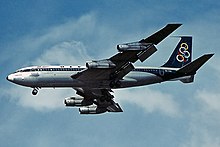
Because of fundamental changes to the wings and the airframe, the Boeing 707-020 can be viewed as an independent model, which is why it received its own type designation as the Boeing 720 . The wing of 707-020 obtained over the entire length of the leading edge Krueger flaps , a greater sweep angle between the fuselage and the inner engines, the profile thickness at the wing root was amplified and the whole machine is more easily constructed, which, among other smaller sized landing gear tires result had . All these changes significantly improved the slow flight behavior, so that the distance required for take-off and landing of the 707-020 was reduced, which is why it could also be used from airports with short runways. The wings designed for the 707-020 were later also used in the B versions of the 707-100 series.
The Boeing 727 served the same market segment shortly after the 720 was launched, but it was more economical to operate, so that a total of only 154 720 machines were built (65 of the basic 720, 89 of the 720B), none of which were in use in 2008 were.
A machine of this type was brought down by remote control in 1984 in the “ Controlled Impact Demonstration ” experiment in order to be able to study various processes during aircraft disasters under defined conditions. The Boeing 720 became the largest remote-controlled aircraft ever.
707-020B (720B)
As with other versions of the Boeing 707, a variant with modern engines was introduced as the Boeing 707-020B . It had Pratt - & - Whitney JT3D-1 - turbofans with a thrust of 75.6 kN respectively. The take-off weight was also increased to 106,200 kg. The first flight of a 720B took place on October 6, 1960, less than a year after the first flight of the base 720. The first of a total of 89 720Bs built was handed over to American Airlines on February 3, 1961 , and Western Airlines received the last machine of this type on September 20, 1967. Many of the original 720s were also upgraded to the 720B stand.
707-100
The Boeing 707-100 was the first variant of the Boeing 707 to be sold in series. Its maiden flight took place on December 20, 1957. The Boeing 707-100 was designed as a medium-haul aircraft for domestic flights within the United States of America. For transatlantic flights, stopovers had to be made to refuel. Powered by four Pratt & Whitney JT3C-6 turbo jets, a maximum of 179 passengers can be transported. A total of 141 civilian 707-100 were produced.
707-138
(38 is the Boeing Customer Code for Qantas)
Boeing built a variant of the Boeing 707-100 especially for Qantas Airways with a fuselage that was shortened by three meters and an optional outer container for a replacement engine . This was later improved by a 15% increase in range and again sold exclusively to Qantas. The first delivery of the 707-138B took place on July 29, 1961, the last on September 10, 1964. Hollywood star John Travolta owns one of the original Qantas 707-138Bs as a private plane with a particularly luxurious interior. On the outside, in accordance with an agreement with the airline, the aircraft bears an exact reproduction of the livery from the 1960s. John Travolta's jet is registered N707JT.
707-100B
The first major improvement to the 707 was the Boeing 707-100B . Among other things, this type was equipped with improved JT3D-1 turbofan engines, which were quieter, more powerful and more fuel-efficient. Each engine produced a thrust of 75.6 kN. This version also got additional slats, as originally designed for the 720, and an enlarged tail unit. In fact, all 707s that were still active and originally delivered as -100 were gradually upgraded to the -100B standard. The first flight of the 707-100B was on June 22, 1960. The first machine of this type was delivered to American Airlines on May 25, 1961 . The last of a total of 72 civilian copies produced was also given to American Airlines on April 22, 1969.
707-200
The Boeing 707-200 was specially developed to be lighter and to be able to carry less payload than the 707-100, but this under much more extreme operating conditions, such as from particularly hot or particularly high-altitude airports. The 707-200 with powerful, also in the 707-300 and the competition model was equipped Douglas DC-8 used Pratt & Whitney JT4 A turbojets , each with 70.2 kN thrust. The first flight of the prototype took place on June 11, 1959, it was lost in a crash on October 19, 1959. Only five 707-200s were produced, all of which went to Braniff International between December 3, 1959 and February 10, 1960 . With the development of the more powerful and economical turbofan engine, as it was used in the 707-100B, the -200 became superfluous relatively quickly, which is why there is no B version of this type.
707-300

The Boeing 707-300 is the first stretched version of the original 707. It was specially designed for long-haul routes, which is why it was nicknamed the Intercontinental . Thanks to a hull stretched around 2.5 m, the 707-300 could hold up to 189 passengers. Various sub-variants of this series were also produced. The Boeing 707-300 achieved a total of 580 units with all variants up to the last delivery in 1982.
707-300 Intercontinental
The Boeing 707-300 is a stretched version of the base model -100, equipped with Pratt & Whitney JT4 A-3 turbojet engines with a thrust of 70.8 kN each. An enlarged wing made it possible to carry more fuel and thus achieve a range that was around 3,000 km longer. Thus, for the first time, non-stop flights across the Atlantic were possible for the 707 without having to make intermediate fuel stops. The maximum take-off weight was 143,330 kg. The 707-300 made its maiden flight on January 11, 1958. First customer Pan Am received the first aircraft on July 19, 1959. A good four years later, on January 17, 1963, Sabena received the last 707-300. A total of 69 copies of this variant were made.
707-300B
The stretched 707-300 was also revised parallel to the -100B. The resulting -300B received some of the structural modifications developed for the -100B, as well as similar Pratt & Whitney JT3D -3 turbofan engines with a thrust of 80 kN each. The take-off weight was increased to 151,950 kg and the wings were once again fundamentally revised. The American military used 707-300B freighters under the designation C-18 . A 707-300B was procured and used by the United States Air Force as the first jet-powered Air Force One . The official name for this special machine was VC-137C . Pan Am received the first 707-300B on April 12, 1962. A total of 174 machines of this type were produced, and many 707-300s were upgraded to the -300B standard. The last brand new 707-300B went to the Argentine government on June 11, 1975 .
707-300C
The Boeing 707-300C was a version that could be flexibly converted from a freighter to a passenger aircraft, which could also be operated in mixed passenger and cargo configurations. It was the most popular variant of the 300 series. Compared to the standard 300B, the -300C had a reinforced cabin floor and a large cargo door on the left front fuselage. Smaller changes compared to the 707-300B included, among other things, new landing gear flaps, additional slat flaps and an additional emergency exit behind the wing (which was necessary for mixed operation as a freighter / passenger aircraft when cargo was transported in the front and passengers in the rear). 335 copies of this variant were produced, some with more powerful JT3D-7 engines, each with 84.4 kN of thrust and a higher take-off weight of 152,400 kg. Although they were theoretically convertible , i.e. flexibly retrofittable, many machines of this type were delivered and used as pure freighters. The first delivery took place on May 2, 1963 to Pan Am, the last on March 10, 1982 to the Air Force of Morocco , which used it as a tanker . Since this 707 was originally produced for test purposes (see 707-700 ) and only later converted into a military tanker and sold, this example is officially the last civilian 707 to be produced.
707-300B Advanced
The Boeing 707-300B is a modification of the Boeing 707-300B to the technical standard of the -300C. As with the 707-300C, the changes included new front landing gear doors, the new wing leading edge and other small changes. In contrast to the 707-300C, the 300B Advanced did not have an additional emergency exit and no cargo door on the left behind the cockpit.
707-400

The Boeing 707-400 is a variant of the 707-300 developed by Boeing at the request of the British Overseas Airways Corporation (BOAC) with British Rolls-Royce Conway Mk 508 turbofan engines, each with a thrust of 77.8 kN. However, the first customer of this version was not BOAC, but German Lufthansa , which ordered four copies on April 24, 1956 (contract signed on January 23, 1957). Air India received the first aircraft on February 18, 1960, the first for Lufthansa followed on February 25, 1960 (rollout was on November 18, 1959). The landing of the first aircraft (D-ABOB) in Hamburg-Fuhlsbüttel took place on March 2, 1960 and the liner service began on March 17, 1960. After only 37 units produced, Varig received the last machine of this type on November 11, 1963. With the 707-400, larger vertical stabilizers were introduced, which from then on were also used for all other versions.
707-700 (project)
The Boeing 707-700 is a test aircraft that was used to check whether it is economically viable and feasible to equip the Boeing 707 with CFM International CFM56 engines and possibly also to retrofit older 707s in this way. The first flight of an aircraft equipped as -700 took place on November 27, 1979. The prototype used was the brand-new last commercial Boeing 707, which was later converted back into the -300C version. The reason for the discontinuation of the project were the twin-engine Boeing 757/767 sister models , which were coming onto the market at the same time , which had similar properties and should not compete with the retrofitted 707. The data collected during the 707-700 test program eventually led to a program in which the US Air Force's 707-based KC-135 / C-135 were upgraded with CFM56 engines. Some later military versions of the 707 also used this type of engine.
Douglas was also pursuing a program to retrofit the Douglas DC- 8-60 with newer engines. Many machines of the DC-8-60 series were finally converted successfully to machines of the DC-8-70 series and thus fulfilled much stricter noise limits than the 707, so that from the late 1980s onwards, significantly more DC-8s than 707s were in commercial use Still in operation, although the 707 was originally much more successful.
707RE
On August 22, 2001 the first time raised an as Boeing 707RE ( R e e - from designated ngined provided with new engines) converted 707-300C. The prototype, which was converted by Seven Q Seven Inc. , is equipped with Pratt & Whitney JT8D -219 engines, which should deliver a thrust of 93 kN each and an increase in performance of around 15%. The aim was to equip both commercial 707 and military KC-135 and E-3 / E-8 with the new engines. The JT8D could easily be installed on any Boeing 707 without major modifications. Although it was possible to demonstrate a 23% reduction in fuel consumption and a 40 dB lower noise level during take-off, the idea did not prevail because of the decline in aviation after September 11, 2001 . After the industry had recovered, certification flights for the engine began in August 2008.
Military versions
C-135 and variants (narrow body)
→ Main articles: Boeing C-135 , Boeing KC-135 , Boeing EC-135 and Boeing RC-135

C-137
As Boeing C-137 Boeing 707 aircraft are called, which are used in the United States Air Force for military purposes. Versions of the United States Air Force's Boeing 707 equipped for the transport of important people are the VC-137A, VC-137B and VC-137C. They were used, among other things, as Air Force One . The Canadian Armed Forces use so-called Boeing CC-137 as tanker and cargo aircraft. Boeing refers to this as Boeing KC-137 .
C-18A
The Boeing C-18A is a version of the Boeing 707, in which aircraft that were formerly used for civil purposes were converted into training aircraft. Four of the aircraft were converted into relay stations for space telemetry called the Boeing EC-18B , and one was converted into the Boeing E-8 .
EC-18B / C / D
The Boeing EC-18B is used as a so-called Advanced Range Instrumentation Aircraft (ARIA) by the US Department of Defense and NASA for airborne radar observation of spaceships and rockets. The Boeing EC-18C is an early designation of the Boeing E-8 , the Boeing EC-18D is a special aircraft for experiments with cruise missiles .
TC-18E, TC-18F
The Boeing TC-18E is a training aircraft for the flying personnel of the AWACS crews, also like the Boeing TC-18F , but which is used for training the Boeing E-6.
EC-137D
Boeing EC-137D were the two prototypes of the AWACS program for a short time.
E-3
The Boeing E-3 with the nickname Sentry is based on the Boeing 707-300 and is a reconnaissance aircraft of the AWACS program that is still in use in various countries. As a Boeing KE-3A , the Saudi Arabia aircraft also serves as a tanker. The E-3s of the French and British air forces are powered by CFM-56 jet engines, while the NATO E-3As stationed in Germany and the American E-3B and E-3C use the original TF-33-100A engines.
E-6
The Boeing E-6 , nicknamed Mercury, flies for the United States Navy as an airborne command and communication center. It is equipped with a large towed antenna for this purpose. CFM-56 are used as engines.
E-8
The Boeing E-8 with the nickname Joint STARS is used by the United States Air Force for battlefield reconnaissance.
use
As one of the first jet airliners, the Boeing 707 was like the other comparable aircraft a prestige object for every airline in its time, accordingly it was used by many airlines worldwide and was considered the standard on long-haul flights in the 1960s. In 1957, the German Lufthansa decided in favor of the Boeing 707, which remained in service until December 1984. Due to the enormous kerosene consumption and the high volume of the engines, this type of aircraft has meanwhile been taken out of service by all major airlines.
As of July 2013, 147 of the 1,010 units produced were still in active service, almost all of them as part of military operations.
The last airline that still operated civil passenger flights with a Boeing 707 was the Iranian Saha Air . On October 26, 2008, the Boeing 707 celebrated 50 years of service as a passenger aircraft in Iran as the first jet in aviation history with a scheduled flight from Saha Air from Tehran-Mehrabad to Mashhad. However, the anniversary flight with flight number IRZ 160 ended after a flight time of almost 20 minutes due to technical problems with the hydraulics of the aircraft with the registration EP-SHU with a successful safety landing in Tehran-Mehrabad. On April 23, 2013, the chairman of the Iranian civil aviation organization announced in an interview that the three remaining Boeing 707 aircraft from Saha Air are no longer allowed to fly and that this airline's license has been removed. The reason given was the safety of the passengers. Saha Air ceased operations at the beginning of 2013, and there are now no more passenger flights in the world with a Boeing 707.
Militarily, however, the Boeing 707 is still widely used today, as are its sister aircraft such as the Boeing C-135 and the Boeing KC-135. In the past, the Boeing 707 also served as a government aircraft for many countries. B. from 1959 to 2001 as Air Force One in the USA. Germany also used the aircraft type until 1999. a. Australia , Republic of the Congo , Israel , Italy , Jordan , Saudi Arabia and Venezuela .
In 1984, in a joint project with the FAA, NASA used the Boeing 720 variant for the Controlled Impact Demonstration , a controlled, remote-controlled crash of the machine.
Operator of the Boeing 720
The following companies operated Boeing 720 (list just started) :
Brand new machines
- Aer Lingus
- Avianca
- El Al
- Ethiopian Airlines
- Lufthansa
- Pakistan International Airlines
- Saudi Arabian Airlines
UNITED STATES:
- American Airlines
- Braniff International Airways
- Continental Airlines
- Eastern Air Lines
- Northwest Airlines
Sales figures
Detailed list of orders and deliveries:
| 707-100 | 707-200 | 707-020 (720) |
707-300 | 707-400 | Military versions |
All in all | |
|---|---|---|---|---|---|---|---|
| Orders: | 141 | 5 | 154 | 580 | 37 | 93 | 1010 |
| Deliveries: | 141 | 5 | 154 | 580 | 37 | 93 | 1010 |
Incidents
From the first flight in 1957 to January 15, 2019, there were 173 total aircraft losses with the Boeing 707. This corresponds to around a fifth (20.21 percent) of all 856 aircraft of this type produced. 3032 people were killed in 81 of the accidents. The total number of total write-offs includes 19 parked machine losses. Overall, the Boeing 707 lost 8.60 per million flights, which - as with the competitor Douglas DC-8 with 8.84 - is above the average of the 1960s and 1970s of around 5. Today's aircraft can be operated much more safely in comparison with values below 0.5. Thirteen total losses with a total of 280 deaths had a warlike or criminal cause, eleven more were due to other events and did not claim any human life.
Technical specifications
| Parameter | 707-100 | 707-138 | 707-200 | 707-020 | 707-300 | 707-400 |
|---|---|---|---|---|---|---|
| length | 44.20 m 44.22 m (B) |
41.00 m | 44.20 m | 41.50 m 41.68 m (B) |
46.61 m | |
| span | 39.88 m | 43.40 m 44.42 m (B & C) |
43.40 m | |||
| Wing area | 226.3 m² | 234.2 m² | 273.7 m² 283 m² (B & C) |
273.7 m² | ||
| height | 12.70 m | 12.62 m 12.55 m (B) |
12.85 m 12.83 m (B) 12.80 m (C) |
12.85 m | ||
| Hull diameter | 3.76 m | |||||
| Max. Range | approx. 8,000 km 8,485 km (B) |
approx. 8,500 km approx. 9,700 km (B) |
approx. 6,500 km | 5,800 km 6,687 km (B) |
8,700 km 9,265 km (B) |
8,700 km |
| Cruising speed | Do 0.83 885 km / h |
Do 0.84 896 km / h |
Do 0.83 885 km / h |
|||
| Max. Takeoff mass | 117,000 kg | 104,000 kg 106,200 kg (B) |
141,700 kg 148,500 kg (B) 151,500 kg (C) |
141,700 kg | ||
| Max. Seats | 179 | 165 | 219 | |||
| typical number of seats | 110 | 106 | 141 | |||
| Engines (4 × each) |
P&W JT3C-6 turbojets at 55.2 kN or P&W JT3D-1 turbofans at 75.6 kN (B version) |
P&W JT4A-3 turbo jets of 70.8 kN |
P&W JT3C-6 Turbojets à 60.1 kN or P&W JT3D-1 Turbofans à 75.6 kN (B version) |
P&W JT4A-3 Turbojets à 70.8 kN or P&W JT3D-3 Turbofans à 80 kN (B-Version) |
Rolls-Royce Conway Mk 508 turbofans at 77.8 kN | |
| Crew (cockpit) | 3 or 4 | |||||
| First flight | December 20, 1957 June 22, 1960 (B) |
March 20, 1959 April 13, 1961 (B) |
May 11, 1959 | November 23, 1959 October 6, 1960 (B) |
January 11, 1959 January 31, 1962 (B) February 19, 1963 (C) |
May 20, 1959 |
Trivia
On August 7, 1955, test pilot Alvin M. "Tex" Johnston flew a barrel roll over Seattle with the original prototype, the Boeing 367-80 . Because a well-known boat race was taking place there at that time, this flight maneuver was filmed. The pilot was reprimanded for his behavior, but the machine became known.
A Boeing 707 plays an important supporting role in the film Airport .
See also
Other types with comparable role, configuration and era
literature
- Hans-Jürgen Becker: Boeing 707 . ISBN 978-3-7654-7227-5 .
- Wolfgang Borgmann: The airplane stars: Boeing 707 , Motorbuch, Stuttgart 2019, ISBN 978-3-613-04190-5
- Alan J. Wright: Boeing 707 . (Classic Civil Aircraft Vol.2), Ian Allen, Shepperton 1990, ISBN 0-7110-1910-X .
Web links
- The 707 on the Boeing website
- "FAA type approval of the 707-100 / -200 (TCDS)" (PDF; 63 kB)
- "FAA type approval of the 707-300 / -400 (TCDS)" (PDF; 92 kB)
- "FAA type approval of 720 (TCDS)" (PDF; 51 kB)
- Detailed description of all 707 variants, including sample images (English)
- Information about the 707RE
- Report on the 50th anniversary flight of the Boeing 707 in Iran
- Bundeswehr Classix: First Boeing 707 (1968) ( YouTube video)
Individual evidence
- ↑ a b 707 Model Summary. boeing.com, accessed April 28, 2013 .
- ^ Peter M Bowers: Boeing Aircraft since 1916. Putnam Aeronautical Books, London 1989, ISBN 0-85177-804-6 , p. 447.
- ^ "Boeing 707." Boeing 707 at Boeing.com . read on October 10, 2012.
- ↑ aerospaceweb.org: Boeing Numbering System
- ↑ TWA reservations training manual ( Memento from August 9, 2014 in the Internet Archive )
- ↑ aerospaceweb.org: Boeing Numbering System
- ↑ http://www.airliners.net/photo/Middle-East-Airlines/Boeing-707-3B4C/1812212/L/
- ↑ FlugRevue April 2010, pp. 92–95, Boeing 707 at Lufthansa
- ^ Pratt JT8D-219 Flight Test Program Gets Underway , Aug. 28, 2008
- ↑ Factsheet (English) of the E-3A Component Geilenkirchen (PDF; 650 kB), on awacs.nato.int, accessed on February 5, 2019
- ↑ Boeing 707 at ch-aviation.ch (English), accessed on July 11, 2013.
- ↑ Austrian Wings - the last civilian B707 operator ceases operations
- ^ Ulrich Klee, Frank Bucher et al .: jp airline-fleets international . Zurich Airport 1966–2001.
- ↑ Boeing 707 accident statistics , Aviation Safety Network (English), accessed on January 15, 2019.
- ↑ Statistical Summary of Commercial Jet Airplanes Accidents (pdf; 153 kB) (English), accessed on January 16, 2019.
- ↑ https://www.youtube.com/watch?v=Ra_khhzuFlE


